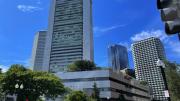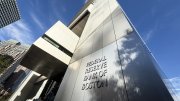For the fiscal year ended June 30, 2021, Harvard Management Company (HMC) reported a 33.6 percent investment return on endowment assets, propelling an $11.3-billion gain in the endowment’s value, to a record $53.2 billion. Unsurprisingly, early reports suggest that nothing like that is in the offing when the University and peers disclose fiscal 2022 results beginning in early autumn. The results merit careful monitoring: distributions from the endowment provided 39 percent of the University’s operating revenue in fiscal 2021—more than twice the share of sponsored-research support or student tuition and fees, the next-largest sources of revenue.
[Updated from the original post of August 22, 2022, on September 23, 2022, 10:35 a.m.: An important indication of universities’ endowment performance has arrived in the form of the 2021-2022 report by the University of Virginia Investment Management Company. UVIMCO invests the smaller ($13.6 billion), but historically excellent (10-year annualized returns of 11 percent), and highly diversified, endowment for that institution. Citing “a highly challenging market environment” in which “equities and bonds lost value during the 12 months ending June 30, 2022,” UVIMCO reported a negative 4.7 percent return during the fiscal year—compared to the historically strong 49 percent return realized during fiscal 2021.
[The report details losses in public equity, long/short equity (hedging), and fixed-income portfolios, partly offset by real assets and absolute return funds. The results included negative returns of 22.6 percent in public equities, 22.9 percent in long/short equities, 4.2 percent in credit assets, and 7.8 percent in fixed-income assets. Private equity, more than one-quarter of assets, yielded a 3.7 percent return—versus 98.7 percent in the prior year. The most robust contributor to results was real assets—nearly 15 percent of the endowment holdings—which realized a 39.2 percent return, where the “resources portfolio, buoyed by appreciating energy prices, served as an important diversifier….” That story is likely to be told to varying degrees by other institutions this year: the only stock-market sectors that yielded strongly positive returns were tied to energy (typically fossil fuels), in a year when the Russian invasion of Ukraine set off huge increases in natural gas, oil, and coal prices. UVIMCO’s absolute return assets (hedge funds), about 8 percent of the portfolio, had a positive 11.2 percent return.
[UVIMCO suggested that in light of high inflation and geopolitical uncertainties, and continuing pandemic effects on the world economy, “the investment environment will likely remain challenging.”
[Although Harvard’s much larger endowment will certainly produce different results, overall and by sector, it is worth noting the similar weighting toward equities (81 percent of assets at June 30, 2021, including an outsized 33 percent allocation to hedge funds; 34 percent of assets were in private equity, which returned 77 percent in fiscal 2021), which drove the fiscal 2021 return (33.6 percent); and the near-total deemphasis on natural resources, other real assets, and real estate (a total of 7 percent of assets last year) as part of the multiyear restructuring of the portfolio undertaken in recent years.]
[Updated October 4, 2022, 11:40 a.m.: Yale reported a positive 0.8 percent return on its endowment investments for fiscal 2022: down sharply from fiscal 2021, when the return was 40.2 percent—but still positive in a year when results in the black may be hard to achieve. Dartmouth reported a negative return: -3.1 percent. Penn reported break-even returns.]
The 2021 result was the highest rate of return earned on Harvard endowment assets since the 43.6 percent of fiscal 1983 (after the Paul Volcker-era shock treatment of high inflation with double-digit interest rates), and edged out the 32.2 percent return of fiscal 2000 (during the dot.com boom). Clearly, a year to savor—even if, as it turned out, some peer institutions with investment teams and strategies that had been in place longer than HMC’s realized fiscal 2021 returns exceeding 40 percent and in a few cases 50 percent. (Harvard’s reported rate of return, and most peers’, is after fees and expenses.)
Adverse Market Conditions
No reasonable person expected that kind of epochal performance—spurred by enormous government and central bank stimulus programs to combat the pandemic’s economic effects—to persist. And indeed, they have not. Recent news reports about the annual compilation of institutional investment returns by the Wilshire Trust Universe Comparison Service (TUCS) suggest just how painful the convergence of high inflation (and higher interest rates), possible recession, war in Ukraine, and the persistent pandemic have been for money managers and their clients. Inside Higher Education reported that compared to the median TUCS college and university endowment return (before fees and expenses) of 27 percent in fiscal 2021, the median result for the 12 months ended this past June 30 was a negative 10.2 percent: the worst showing since the financial crisis in fiscal 2009 (and a 37-percentage-point deterioration, year-over-year).
The financial markets were, to say the least, unforgiving. Accelerating inflation, and central bank decisions to raise interest rates, reduced the value of standard U.S. bond portfolios by more than 5 percent in the last quarter of the fiscal year (March-June), and more than 10 percent for the year, according to a Wilshire news release. U.S. stocks depreciated about 17 percent in the quarter and 13 percent for the year, according to Wilshire’s calculations. International stocks declined even more.
None of this is directly indicative of HMC’s likely results, or those of other large, highly diversified university endowments, which tend to underweight public stock and bond holdings, and to have portfolios heavily committed to private equities (including venture capital), hedge funds, and other categories of assets. As of June 30, 2021, HMC’s investments were skewed toward private equity (34 percent of assets), hedge funds (33 percent), public equities (14 percent), and cash (8 percent), following its decisions in prior years to deemphasize real estate (5 percent), write down or dispose of natural resources and other real assets (2 percent, collectively), and maintain a relatively minimal bond position (4 percent).
Those diversified assets apparently buffered the recent declines in stocks and bonds to some extent; Bloomberg reported that TUCS’s class of “large” endowments (those with assets exceeding $500 million, a fraction of Harvard and its closest peers’ investments) realized a positive median return (before fees and expenses) of 0.9 percent in fiscal 2022. (They also realized a 34 percent median return in the prior year, besting the all-endowments median of 27 percent—but still, for these larger, more diversified portfolios, a 33-point reduction in returns.)
The giant California Public Employees’ Retirement System or CalPERS (with $440 billion in assets as of June 30) reported preliminary results for fiscal 2022 on July 20: a net investment return of negative 6.1 percent (versus a positive 21.3 percent return the prior year). CalPERS said global public equities depreciated 13.1 percent (a full 49-percentage-point swing from fiscal 2021), while fixed-income investments yielded a negative 14.5 percent return (versus essentially break-even returns in 2021). Its private equity and real assets funds produced returns of 21.3 percent (far ahead of market benchmark returns of 8.3 percent) and 24.1 percent, respectively. Importantly, however, the latter two asset classes were valued as of March 31, so any deterioration in the fiscal fourth quarter was not reflected in CalPERS’s overall negative 6.1 percent rate of return for the year. Private equity includes a wide array of asset types, but it is unlikely that all of them were able to defy gravity in the final quarter of the fiscal year, so that seemingly robust rate of return may ultimately come down; real assets may include some holdings that have done very well under recent conditions (energy-related investments, for example), and others yielding mixed performance (certain categories of real estate).
Harvard’s Prospects
Last year, HMC came in for some criticism for reporting an investment return of “only” 33.6 percent: a result of investment decisions made as long as a decade ago, under prior management pursuing different strategies, when the University’s tolerance for risk was much reduced in the wake of the staggering, multibillion-dollar investment losses it incurred in 2008-2009.
N.P. Narvekar, HMC’s chief executive since late 2016, has implemented top-to-bottom changes in the organization, aimed at enhancing investment returns over the course of market cycles. The span of that formula is important: it means realizing competitive investment returns when market conditions are favorable, and minimizing severe losses when they are, inevitably, unfavorable. Over a decade or so, the reasoning goes, that sort of discipline should produce superior results, in support of the University’s long-term academic mission (with continuing support from a well-run, perpetual endowment).
Will HMC report dazzling returns this fall, along the lines of last year’s results? Perhaps that is not impossible—but it is difficult to envision outperformance by enormous, double-digit percentage-point margins across all the asset classes in the portfolio. Of perhaps greater interest will be seeing whether the organization’s disciplined decisions result in relative outperformance in a down year, when many peers would likely be happy with slightly positive, or even breakeven, returns after their fizzy 2021 outcomes.
The numbers will become available this fall. Given extraordinarily volatile financial markets—up the roller coaster in fiscal 2021, and swiftly down this past year—HMC’s results promise to be an illuminating test of its strategic pursuit of consistent, superior performance over the long term.









